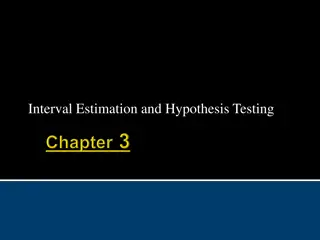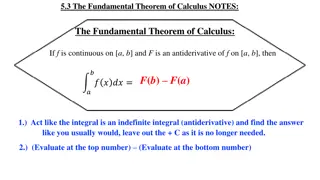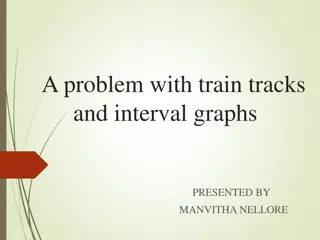Interval Scheduling Algorithms and Pigeon Carriers
Scheduling algorithms for resource allocation with real-world examples like classroom scheduling and fire pit usage. Delve into the efficiency of labeling overlapping intervals and the concept of depth in a set of intervals. Additionally, engage in a fun problem involving two friends, bikes, and a speedy pigeon courier.
Download Presentation

Please find below an Image/Link to download the presentation.
The content on the website is provided AS IS for your information and personal use only. It may not be sold, licensed, or shared on other websites without obtaining consent from the author.If you encounter any issues during the download, it is possible that the publisher has removed the file from their server.
You are allowed to download the files provided on this website for personal or commercial use, subject to the condition that they are used lawfully. All files are the property of their respective owners.
The content on the website is provided AS IS for your information and personal use only. It may not be sold, licensed, or shared on other websites without obtaining consent from the author.
E N D
Presentation Transcript
What did we talk about last time? Topological sort Greedy algorithms Interval scheduling
Two friends who live 36 miles apart decide to meet and start riding their bikes towards each other. They plan to meet halfway. Each is riding at 6mph. One of them has a pet carrier pigeon who starts flying the instant the friends start traveling. The pigeon flies back and forth at 18mph between the friends until the friends meet. How many miles does the pigeon travel?
What if all intervals need to be scheduled? Example: Lectures are intervals and resources are classrooms Example: Roasting pigs are intervals and resources are fire pits The problem is to find the minimum number of resources needed to satisfy all intervals The book calls this problem interval partitioning
Intervals to schedule (arranged unhelpfully): Intervals to schedule (arranged helpfully): The depth d of a set of intervals is the maximum number that pass a single point on the time-line
Sort intervals by their start times Let I1, I2, , Inbe the ordered intervals For j= 1, 2, 3, ..., n For each interval Iithat precedes Ijin sorted order and overlaps it Exclude the label of Iifrom consideration for Ij If there is any label from {1, 2, , d} that has not been excluded Assign that label to Ij Else Leave Ijunlabeled
Claim:In our algorithm, every interval will be assigned a label, and no two overlapping intervals will receive the same label. Proof:Consider interval Ij, and suppose there are tintervals earlier in the sorted order that overlap it. These tintervals with Ijform t+ 1 intervals that pass over a common point on the time-line. Thus, t+ 1 dand t d 1. Thus, there must be at least one label left to be assigned to Ij.
To show that no two overlapping intervals are assigned the same label, consider two intervals Iand I'that overlap. Suppose that I precedes I'in the sorted order. When I'is considered by the algorithm, Iis in the set of intervals whose labels are excluded.
Consider a problem with requests that are not fixed in time Instead, each request i has a deadline diand requires time ti using the resources If the finish time f(i) > di, its lateness li= f(i) di If the finish time f(i) di, its lateness li= 0 One goal we could have is to minimize the maximum lateness of any given job We don't care about the sum of the lateness, just the single job that is the most overdue
Deadline = 2 Job 1: Deadline = 4 Job 2: Deadline = 6 Job 3: Solution: Lateness = 0
Which request do we schedule next? Shortest jobs first? No, we could have short jobs with late deadlines Jobs with the least slack time (di ti) No, consider Job 1 with t1 = 1 and d1 = 2 and Job 2 with t2 = 10 and d2 = 10 Sort by order of increasing deadlines? Surprisingly, yes! Length of job doesn't matter
Sort the jobs in increasing order of deadlines For simplicity, relabel jobs and deadlines so that d1 d2 dn Set f = s For i= 1, 2, , n Assign job i to the interval from s(i) = f to f(i) = f + ti Set f = f + ti
Idle time is time when no jobs are scheduled but there are still jobs left (gaps) There is an optimal schedule with no idle time We will use an exchange argument to transform the optimal schedule O into the schedule A we produce We say that a schedule has an inversion if a job i with deadline di is scheduled before a job j with an earlier deadline dj < di Our algorithm produces a schedule with no inversions
Proof: If two different schedules have neither inversions nor idle time, they might not produce the same order of jobs, but they can only differ in the order in which jobs with identical deadlines are scheduled. Consider such a deadline d. In both schedules, the jobs with deadline dare all scheduled consecutively (after all jobs with earlier deadlines and before all jobs with later deadlines). Among the jobs with deadline d, the last one has the greatest lateness, and this lateness does not depend on the order of the jobs.
Proof: We know there is an optimal schedule O with no idle time. If O has an inversion, then there is a pair of jobs i and j such that j is scheduled right after i and has dj < di. If there were no inversions, all of the deadlines would be in order, but the fact that there is an inversion means that some point will be reached where a job has an earlier deadline than the job before it. Let that job be i and the previous job be j. If we swap i and j, we get a schedule with one fewer inversion.
Original schedule O (before swapping) Job i Job j Schedule O' (after swapping) Job j Job i Nothing other than i and j are affected
This new swapped schedule has a maximum lateness no larger than that of O. Why? Since there are no gaps, the only things affected are jobs i and j. (Nothing before or after changes.) Job j is finishing earlier, so its lateness will not increase. We will use a prime (') to differentiate quantities in the swapped schedule. Now, f'(i) = f(j) and remember that di > dj li' = f(j) di < f(j) dj = lj The old maximum lateness L lj > li' Thus, the new maximum lateness L' will not be greater
Claim: The schedule A produced by the greedy algorithm has optimal maximum lateness. Proof: The previous proof shows that we can construct a schedule without inversions as good as any optimal one with inversions. The proof before that says that all schedules with no inversions and no idle time have the same maximum lateness. Since our algorithm finds a schedule without inversions and no idle time, it must be optimal.
Directed graph G = (V, E) with start node s Assume that there is a path from s to every other node (although that's not critical) Every edge e has a length le 0 For a path P, length of Pl(P) is the sum of the lengths of the edges on P We want to find the shortest path from s to every other node in the graph An undirected graph is an easy tweak
Let's first look at the length of the paths, not the actual paths We keep set S of vertices to which we have determined the true shortest-path distance S is the explored part of the graph Then, we try to find the shortest new path by traveling from any node in the explored part S to any node v outside We update the distance to v and add v to S Then, continue
Let Sbe the set of explored nodes For each u S, we store a distance d(u) Initially S= {s} and d(s)= 0 While S V Select a node v Swith at least one edge from Sfor which d'(v)= mine=(u,v):u Sd(u)+ leis as small as possible Add vto Sand define d(v)= d'(v)
3 C 2 B 4 J 2 9 3 A 6 8 13 F 2 3 I 7 D H 4 17 3 4 G E 1
Claim: For each uS, the path Pu is a shortest s-u path Proof by induction on the size of S: Basis case: (n = 1) |S| = 1 means S = {s} and d(s) = 0 Clearly, that's the best distance to s Induction step: (n = k) Assume that when |S| = k for k 1, S contains the shortest paths for everything in S
Suppose we are increasing S to size k + 1 by adding node v. Let (u, v) be the final edge on our s-v path Pv. By the induction hypothesis, Pu is the shortest s-u path for all u S. Consider any other s-v path P. Since v is not in S, P must leave S somewhere. Let y be the first node on P that is not in S, and let x S be the node just before y.
On step k + 1, we could have added y, but we didn't. Thus, there is no path from s to y through x that is shorter than Pv. But the subpath of P up to y is such a path, so that subpath must be at least as long as Pv. Since edge lengths are nonnegative, P is at least as long as Pv. Thus, Pv must be the shortest path to v.
You can think of Breadth-First Search as a pulse expanding, layer by layer, through a graph from some starting node Dijkstra's algorithm is the same, except that the time it takes for the pulse to arrive is based not on the number of edges, but the lengths of the edges it has to pass through Because Dijkstra's algorithm expands from the starting point to whatever is closer, it grows like a blob There are algorithms that, under certain situations, can cleverly grow in the direction of the destination and will often take less time to find the path there
For n nodes, the While loop runs n 1 times In the worst case, we might need to look at all the edges to compute appropriate minima for each iteration Yielding a running time of O(mn) It turns out that using a priority queue allows us to get the time down to O(m log n) Some deep data structure work has been done here, and I don't want to go into it Read the literature if you want to implement the algorithm as fast as possible
Finish Dijkstra's Minimum spanning trees Review
Finish Assignment 2 Due Friday before midnight Review chapters 1 through 3 Exam 1 is next Monday All office hours are canceled today























